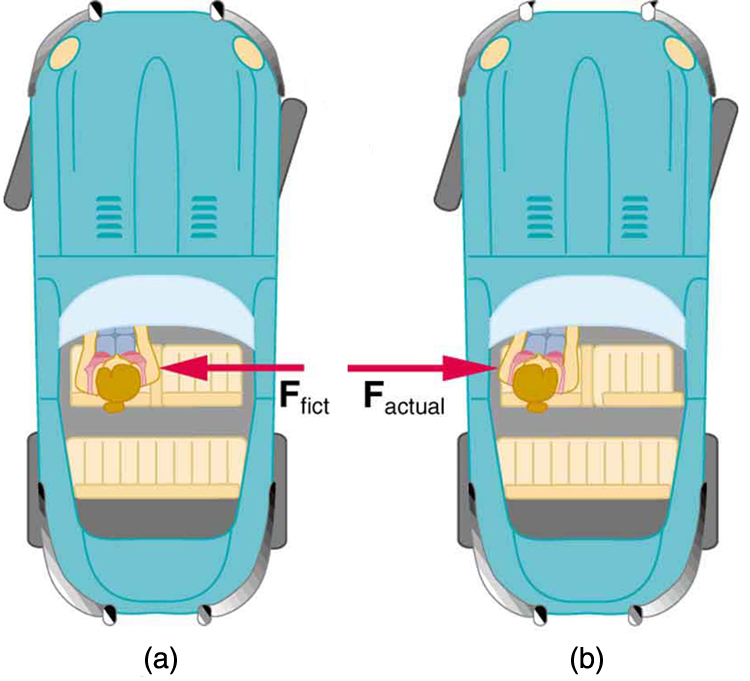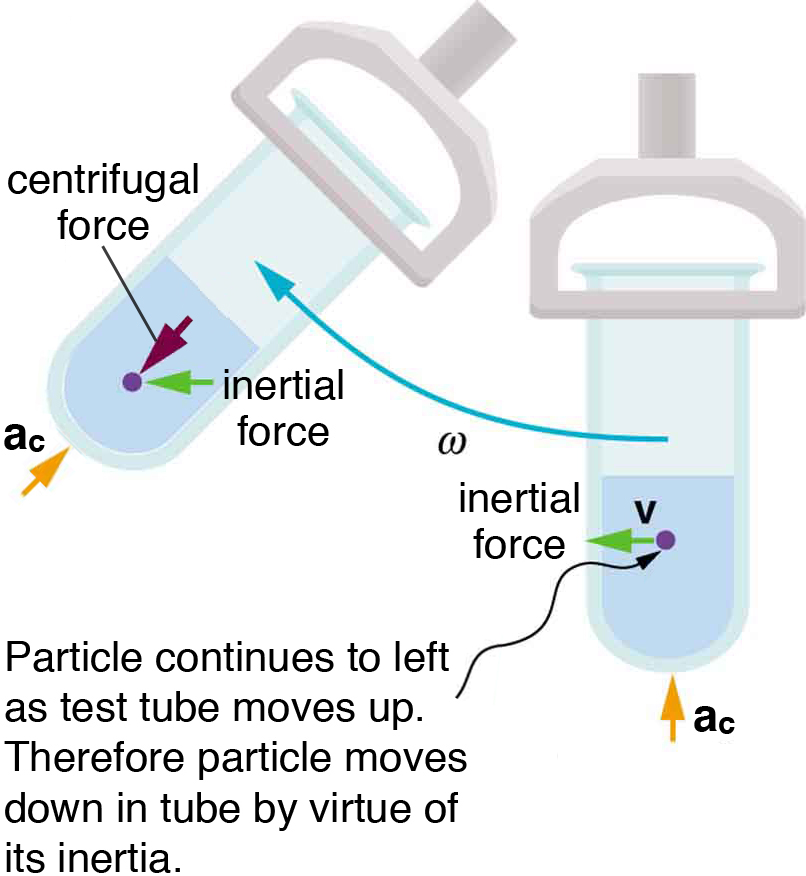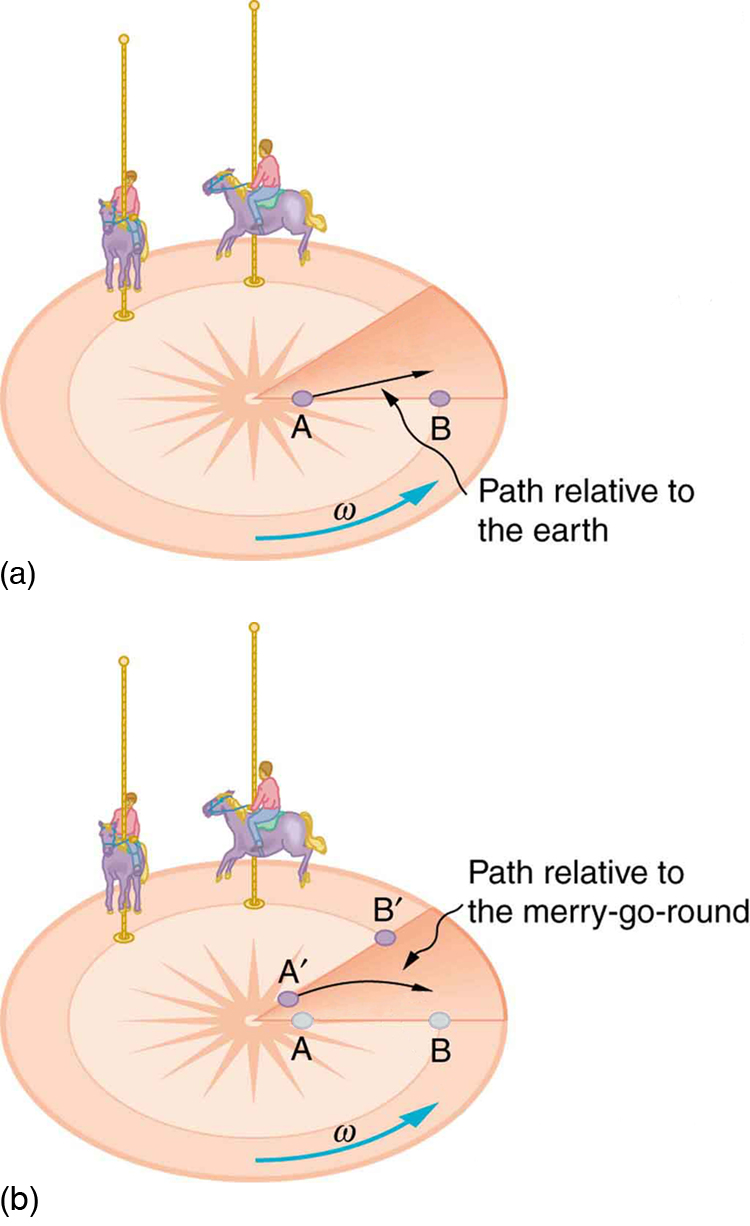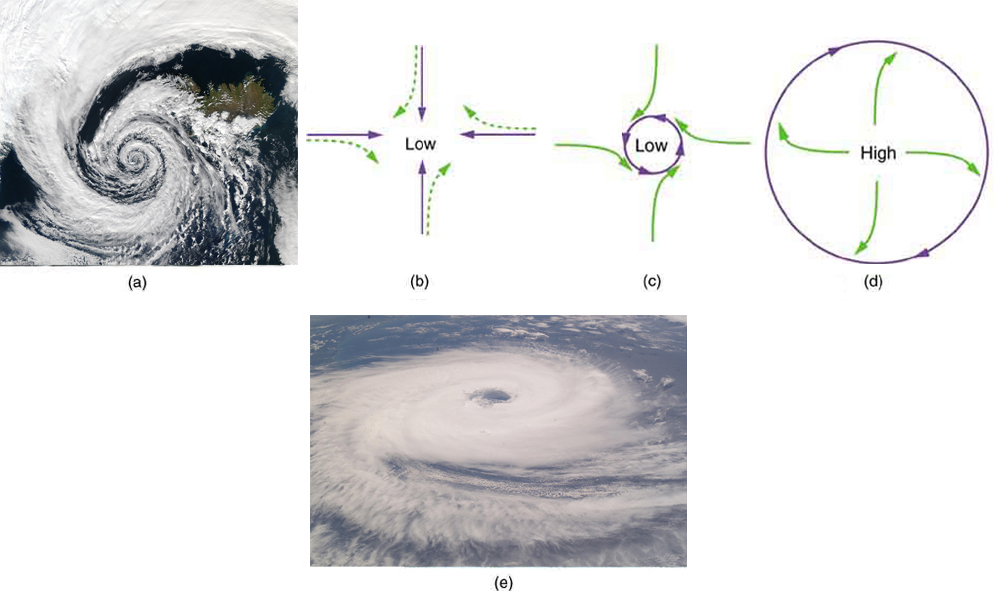Uniform Circular Motion and Gravitation
38 Fictitious Forces and Non-inertial Frames: The Coriolis Force
Learning Objectives
-
Distinguish between inertial and non-inertial frames of reference.
-
Understand the origin and effects of fictitious forces, including the centrifugal and Coriolis forces.
-
Describe how the Coriolis force influences large-scale natural phenomena like hurricanes.
Fictitious Forces and Accelerated Frames
Experiences such as taking off in a jet, making a sharp turn in a car, or riding a merry-go-round all involve fictitious forces—forces that seem real but arise solely from observing motion in an accelerating or rotating frame of reference.
Inertial vs. Non-Inertial Frames
An inertial frame of reference is one in which Newton’s laws hold in their simplest form, and all forces have identifiable physical origins. For example, Earth is typically considered an approximately inertial frame, especially for most terrestrial motion.
In contrast, a non-inertial frame of reference is one that is accelerating. Observers in such frames perceive fictitious forces to explain observed motion. These forces do not arise from any physical interaction, but instead from the acceleration of the observer’s frame.
🚗 Turning in a Car
When a car makes a right turn, passengers feel as if they’re being pushed to the left. In the car’s frame (non-inertial), this appears to be a real force. However, in Earth’s frame (Figure 38.1), the car is simply accelerating rightward beneath the passengers, and no leftward force actually exists.

🎠 Riding a Merry-Go-Round
On a rotating merry-go-round (Figure 38.2), riders feel a force trying to fling them outward. This is called centrifugal force, a fictitious force that explains the rider’s motion within the rotating frame. In the inertial (Earth) frame, the rider’s inertia causes them to move in a straight line, and it is the centripetal force (e.g., from the handrail) that keeps them moving in a circle.

The Centrifuge: Inertia in Action
A centrifuge (Figure 38.3) spins rapidly to accelerate particles radially outward due to their inertia. In the centrifuge’s rotating frame, this is explained using a fictitious centrifugal force. In an inertial frame, the test tube provides the centripetal force that keeps particles in circular motion, while inertia causes sedimentation toward the walls.

The Coriolis Force
Now consider what happens when an object moves within a rotating frame.
Imagine sliding a ball straight outward from the center of a spinning merry-go-round. In the Earth frame, the ball travels in a straight path. However, observers on the rotating platform (Figure 38.4?) see the ball curve to the right. This apparent curvature is explained by a fictitious force called the Coriolis force.

🌀 Coriolis Force in Earth Systems
Earth itself is a slowly rotating frame. While often negligible, its rotation does produce observable effects over large distances and timescales. For example:
-
In the Northern Hemisphere, the Coriolis force deflects moving air to the right.
-
In the Southern Hemisphere, it deflects air to the left.
This deflection leads to the counterclockwise rotation of hurricanes in the north and clockwise rotation in the south (Figure 38.5).

Section Summary
-
Fictitious forces (centrifugal, Coriolis) arise only in non-inertial frames.
-
In an inertial frame, Newton’s laws explain motion without invoking fictitious forces.
-
The centrifugal force explains outward motion in a rotating frame.
-
The Coriolis force explains the deflection of moving objects in a rotating frame.
Despite being “fictitious,” these forces are useful for making sense of motion within accelerating frames, and they are mathematically necessary for applying Newton’s laws in such contexts.
Conceptual Questions
- When a toilet is flushed or a sink is drained, the water (and other material) begins to rotate about the drain on the way down. Assuming no initial rotation and a flow initially directly straight toward the drain, explain what causes the rotation and which direction it has in the northern hemisphere. (Note that this is a small effect and in most toilets the rotation is caused by directional water jets.) Would the direction of rotation reverse if water were forced up the drain?
- Is there a real force that throws water from clothes during the spin cycle of a washing machine? Explain how the water is removed.
- In one amusement park ride, riders enter a large vertical barrel and stand against the wall on its horizontal floor. The barrel is spun up and the floor drops away. Riders feel as if they are pinned to the wall by a force something like the gravitational force. This is a fictitious force sensed and used by the riders to explain events in the rotating frame of reference of the barrel. Explain in an inertial frame of reference (Earth is nearly one) what pins the riders to the wall, and identify all of the real forces acting on them.
- Action at a distance, such as is the case for gravity, was once thought to be illogical and therefore untrue. What is the ultimate determinant of the truth in physics, and why was this action ultimately accepted?
- Two friends are having a conversation. Anna says a satellite in orbit is in freefall because the satellite keeps falling toward Earth. Tom says a satellite in orbit is not in freefall because the acceleration due to gravity is not 9.80 [latex]{\text{m/s}}^{2}[/latex]. Who do you agree with and why?
- A non-rotating frame of reference placed at the center of the Sun is very nearly an inertial one. Why is it not exactly an inertial frame?
Glossary
- fictitious force
- a force having no physical origin
- centrifugal force
- a fictitious force that tends to throw an object off when the object is rotating in a non-inertial frame of reference
- Coriolis force
- the fictitious force causing the apparent deflection of moving objects when viewed in a rotating frame of reference
- non-inertial frame of reference
- an accelerated frame of reference
a force having no physical origin
an accelerated frame of reference
a fictitious force that tends to throw an object off when the object is rotating in a non-inertial frame of reference
the tendency of an object to remain at rest or remain in motion
any net force causing uniform circular motion
the fictitious force causing the apparent deflection of moving objects when viewed in a rotating frame of reference

